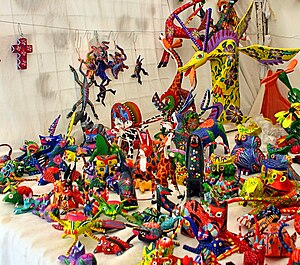율란펜수트라
Yulanpen Sutra| 율란펜수트라 | |||||||||
|---|---|---|---|---|---|---|---|---|---|
 뮬리언과 그의 어머니 류 마담(19세기) | |||||||||
| 중국어 번체 | 《盂蘭盆經》 | ||||||||
| 중국어 간체 | 《盂兰盆经》 | ||||||||
| 문자 그대로의 뜻 | 율란사발경전 | ||||||||
| |||||||||
| 대체명 | |||||||||
|---|---|---|---|---|---|---|---|---|---|
| 중국어 번체 | 《佛說盂蘭盆經》 | ||||||||
| 중국어 간체 | 《佛说盂兰盆经》 | ||||||||
| 문자 그대로의 뜻 | 부처가 말하는 율란그릇의 경전 | ||||||||
| |||||||||
율란펜경(전통 중국어: 盂蘭經;;; pinyin:ylanpén-j;; 일본어 발음: 우라본쿄; 한국어: 란경경; 베트남어: KinhVu Lan Bồ)은 효행에 관한 마하야나 경전이다. 인디케이터어(역사 참조)에서 번역되었으며, 수집된 경전 섹션의 제3권인 16권의 타이쇼 685와 타이쇼 686에 수록되어 있다.[1] 타이쇼 685는 기원전 265년부터 311년까지 다마락사가 번역한 것으로 '불상은 율란펜라를 말한다'라는 제목이다. 타이쇼 686은 동진 시대에 알려지지 않았거나 잃어버린 번역가에 의해 번역되었으며, '부처는 은혜를 갚기 위해 그릇을 바치는 경전을 말한다'라는 제목의 책이다. 가라시마에 따르면, 타이쇼 686은 기본적으로 타이쇼 685를 보다 관용적으로 각색한 것이라고 한다.[3] 이 책은 석가모니불의 제자 중 한 명인 마우드갈랴야나가 압히냐를 성취한 후 일어난 일들을 기록하고 있으며, 그의 새로운 힘을 이용해 돌아가신 부모를 찾고 있다. 결국, 마우드갈랴야나는 프리타(헝가리 귀신)세계에서, 부처님의 도움으로 어머니를 구할 수 있다는 것을 알게 된다.[4] 동아시아 귀신 축제는 이 경전을 바탕으로 한다.
역사
율란펜 경전은 전통적으로 265년에서 311년 사이에 진 휘하의 다르마락가가 산스크리트어에서 중국어로 번역한 것으로 여겨져 왔다.[5] 율란펜 경전의 주제는 다른 경전에 서술된 몇 가지 설명과 대체로 비슷하다. 그 중 가장 오래된 설명(페타바투 제14호 - 사리푸타 어머니의 이야기)은 제자인 사리푸타가 프리타나 배고픈 귀신이 된 어머니를 어떻게 구해냈는지를 기술하고 있다. 율란펜 경전과 마찬가지로 사십오분의 상하를 위해 네 개의 오두막을 짓고 그 안에 음식과 음료를 채우며 부처가 있는 가운데, 그는 고통받는 어머니를 위해 이 기부를 한다. 공로전환으로 사리푸타의 어머니가 다시 태어나 프리타 세계에서 풀려날 수 있게 된 것이다.[6] 또 다른 계정은 아바다나타카에서 찾을 수 있는데, 율란펜수트라와 매우 유사하다: 모우드갈랴야나는 수도사회를 위해 프타스를 대신하여 제물을 바치는 친척들과 오백 명의 프리타를 대신하여 소통한다. 공로 전이가 완료되면 이전의 프리타들은 다시 태어나고 고통에서 해방된다.[7]
내용물
이 경전은 무드갈랴나가 아비냐를 성취한 시기를 기록하고 있으며, 그의 새로운 힘을 이용해 돌아가신 부모를 찾아다닌다. 무드갈랴야나는 죽은 어머니가 프레타나 배고픈 유령 영역으로 다시 태어난 것을 발견한다. 그녀는 허탈한 상태였고 모우드갈랴야나는 그녀에게 밥 한 그릇을 주면서 그녀를 도우려 했다. 불행히도 프리타로서 그녀는 그 쌀이 불타는 석탄으로 변하여 먹을 수 없었다. 모우드갈랴야나는 부처님께 도와달라고 부탁하는데, 부처님은 프라바라나(장마가 끝나거나 바사가 끝나는 시기)에 상하나 수도회에 기꺼이 식량 등을 바쳐 이 생애와 지난 7년 동안 어떻게 현재의 부모와 죽은 부모를 도울 수 있는지 설명한다. 7월 7일, 수도회에서 돌아가신 부모에게 공적을 전가하는 [8][9][10]등
레거시
이 경전은 징추수이시지와 같은 중국의 축제 안내자들이 거의 즉시 집어 들고, 중국의 유령 축제의 창조에 영향을 주었고, 이는 다시 일본의 본 축제와 같은 동아시아 전역의 다른 유령 축제에 영향을 주었다.
참고 항목
참조
인용구
- ^ 타이쇼 685호와 686호 모두 타이쇼 트리피타카 16권에 수록되어 있다."Taishō Shinshū Daizōkyō" 大正新脩大藏經 [Taishō Shinshū Tripitaka]. CBETA 漢文大藏經 (in Chinese).
This is an index to the Taisho Tripitaka - nb Volume 16 is listed as 經集部 or Collected Sutra Section; it is where Taisho 685 (The Buddha Speaks the Yulanpen Sutra) and Taisho 686 (The Buddha Speaks the Sutra of Offering Bowls to Repay Kindness) are located.
- ^ Karashima Seishi (March 2013). "The Meaning of Yulanpen 盂蘭盆 "Rice Bowl" On Pravāraṇā Day" (PDF). Annual Report of the International Research Institute for Advance Buddhology at Soka University for the Academic Year 2012. XVI: 289.
{{cite journal}}: CS1 maint: 작성자 매개변수 사용(링크) - ^ 辛嶋静志 Karashima Seishi (October 2013). 「盂蘭盆」の本当の意味 ―千四百間の誤解を解く [The Real Meaning of Urabon [Yulanpen] –The Solution to a 1400 Year Misunderstanding]. 大法輪 (The Great Wheel of the Dharma) (in Japanese): 182.
ほぼ同じ内容の「報恩奉盆経」という経典ものあるがこれは前者がいかにも直訳だったものを中国的に改めたものにすぎない。(see text for translation)
{{cite journal}}: CS1 maint: 작성자 매개변수 사용(링크) - ^ 6개 영역 참조
- ^ Karashima Seishi (March 2013). "The Meaning of Yulanpen 盂蘭盆 "Rice Bowl" On Pravāraṇā Day" (PDF). Annual Report of the International Research Institute for Advance Buddhology at Soka University for the Academic Year 2012. XVI: 289,301,302.
p.302 -Although this sutra has often been regarded as apocryphal [Japanese version has in recent times], the contents and ideas in it are well rooted in India as we have seen above. In addition to that, the vocabulary and usage of Chinese words are more archaic, compared with Kumārajīva's corpus (401-413 CE), while they resemble greatly the translations by Dharmarakṣa (fl. 265?-311 CE). Moreover, the transliteration 鉢和羅 (EH pat γwa la > MC pwât γwâ lâ} of Skt. pravāra(ṇā), which only occurs in this sutra and its adaptation, i.e. the Baoen Fengpen jing 報恩奉盆經 (T. 16, no. 686, 780a20), indicates clearly that this sutra is not apocryphal but a genuine translation, because only somebody who knew the original Indian form was able to transliterate it thus correctly into Chinese. In conclusion, I assume [<-missing in Japanese version] that this sutra is not apocryphal, but a translation from an Indian text translated by Dharmarakṣa or somebody else in pre-Kumārajīva times [Japanese version has 3rd to 4th century CE]. [c.f. p 189 for equivalent in Japanese version] Also c.f. p 301 for derivation of Yulan from Middle Indic (Gandhari) *olana.
{{cite journal}}: CS1 maint: 작성자 매개변수 사용(링크) - ^ 페타바투는 또한 팔리 캐논의 일부인 후다카 니카야의 일부분이며 프리타 영역에서 재탄생의 카르마 기원을 설명하는 51개의 구절을 포함하고 있다. 그것에 대한 가장 초기의 언급은 마힌다 스님이 기원전 3세기 스리랑카 사람들을 가르치기 위해 그것을 사용했다고 기록한 마하밤사에 있다. 페타바투는 유사한 고스트 페스티벌이 남아시아와 동남아시아 전역에 퍼지게 한 책임이 있다.cf Langer(2007) [1]
- ^ Karashima Seishi (March 2013). "The Meaning of Yulanpen 盂蘭盆 "Rice Bowl" On Pravāraṇā Day" (PDF). Annual Report of the International Research Institute for Advance Buddhology at Soka University for the Academic Year 2012. XVI: 297–8.
{{cite journal}}: CS1 maint: 작성자 매개변수(링크) 사용. 이 계정의 산스크리트 조각도 발견되었다. - ^ 辛嶋静志 Karashima Seishi (October 2013). 「盂蘭盆」の本当の意味 ―千四百間の誤解を解く [The Real Meaning of Urabon [Yulanpen] –The Solution to a 1400 Year Misunderstanding]. 大法輪 (The Great Wheel of the Dharma) (in Japanese): 185.
東アジアの盂蘭盆と東南アジアのワン・オ一クパンサーなどは、いずれも、釈尊の時代に規定された様に七月十五日の自恣の日を祝っているのだが(日本ではこのことはすでに意識されていない)、東南アジアでは古代インドの暦に基づいて行われるのに対し、東アジアでは、中国の太陰暦に従っているので、ニケ月の差があり、これらが同一の行事ということに気付く人は少ない。English Translation: Both the East Asian Urabon [Yulanpen] and Southeast Asian Wan Ok Phansa [Thai name for Pravāraṇā] are celebrated on the 15th day of the seventh month, the day of Pravāraṇā just as it was promulgated in Lord Buddha's time (in Japan, this matter is not known to people). In Southeast Asian countries, they use the ancient Indian calendar [or Buddhist calendar] as opposed to East Asian countries where they use the Chinese calendar. As there is a two month difference between the two calendars, few people realized that the two are [in fact] the same event.
{{cite journal}}: CS1 maint: 작성자 매개변수 사용(링크) - ^ Karashima Seishi (March 2013). "The Meaning of Yulanpen 盂蘭盆 "Rice Bowl" On Pravāraṇā Day" (PDF). Annual Report of the International Research Institute for Advance Buddhology at Soka University for the Academic Year 2012. XVI: 293.
Pravāraṇā (Pāli Pavāraṇā) zizi 自恣 and suiyi 隨意 in Chinese, is a ceremony held at the end of the three-month rainy season retreat [also called vassa] by Buddhist monks. In Theravada Buddhism and in Nepal, it was and is still held on the full moon day of the seventh or eight month. i.e. Āśvina (September–October) or Kārttika (October–November) respectively.
{{cite journal}}: CS1 maint: 작성자 매개변수 사용(링크) - ^ 辛嶋静志 Karashima Seishi (in Chinese -辛島靜志) (February 2014). Translated by 裘雲青 (Qiu Yunqing). 盂蘭盆之意-自恣日的“飯鉢” [The Meaning of Yulanpen 盂蘭盆 "Rice Bowl" On Pravāraṇā Day]. 中華文史論叢 (title tr. to English - Journal of Chinese Literature and History) (in Chinese) (114): 286.
對佛教徒來說,自古印度年曆(元旦相當於公曆三月中至四月中)四月十五日(公曆六至七月)或五月十五日(公曆七至八月)開始的三個月是雨安居。直至今天,西藏、尼泊爾、東南亞地區的僧人依然在此期間行雨安居。這一習俗也傳到沒有雨季的中國大陸中原地域,年曆和數字被原封不動地保留下來,但由印度年曆變為中國太陰曆。在中國、日本、朝鮮半島等東亞地區,雨安居從陰曆四月(公曆五月)開始,持續三個月。English Translation: From the Buddhist viewpoint, based on the Ancient Indian calendar [or Buddhist calendar] (New Years is in the middle of March to the middle of April [in the Gregorian calendar]) the 15th day of the fourth month [Āṣāḍha] (June to July [in the Gregorian calendar]) or the 15th day of the fifth month [Śrāvaṇa] (July to August [in Gregorian calendar]) is the start of three month period called vassa. From ancient times to even today, the monastic community of Tibet, Nepal and Southeast Asia still follow this schedule to observe vassa. This custom was also transmitted to China which does not have a rainy season, the calendar and dates preserved unchanged from the original but instead of using the ancient Indian calendar, the lunar Chinese calendar is used. In China, Japan, the Korean peninsula and other East Asian regions, vassa starts on the fourth month of the lunar Chinese calendar (May (in the Gregorian calendar) and lasts 3 months. [n.b. Since the start of vassa is fixed in East Asia in the fourth month, Pravāraṇā is also fixed to the 15th day of the seventh month].
{{cite journal}}: CS1 maint: 작성자 매개변수 사용(링크)
참고 문헌 목록
- Bandō, Shōjun, ed. (2005), "The Ullambana Sutra (Taishō Vol. 16, No. 685)", Apocryphal Scriptures (PDF), Bukkyō Dendō Kyōkai English Tripitaka Series, Berkeley: Numata Center for Buddhist Translation and Research, pp. 17–44, ISBN 1-886439-29-X, archived from the original (PDF) on 2013-02-10.
- Langer, Rita (2007), Buddhist Rituals of Death and Rebirth: Contemporary Sri Lankan Practice and Its Origins, Abingdon: Routledge, ISBN 9781134158720.
- Mair, Victor H. (1989), T'ang Transformation Texts, Cambridge: Harvard University Press, ISBN 9780674868151.
외부 링크
| Chinese Wikisource는 이 기사와 관련된 원문을 가지고 있다. |
- 『불교지문번역회』의 『울암바나경』
- SFSU에서 "효를 실천해야 하는가?"
- 《佛說盂蘭盆經》 (중국어로)
- 니치렌 다이쇼닌의 「우라본」


